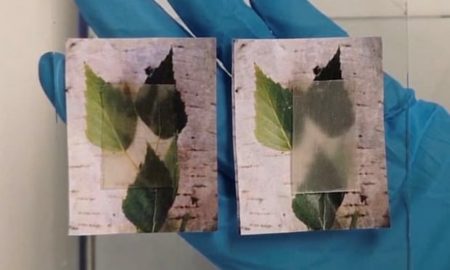August 13, 2019 – Swedish researchers at the KTH Royal Institute of Technology in Stockholm, earlier this year presented a new product at a meeting of the American Chemical Society, that should it move from the laboratory into production, could significantly disrupt the construction materials industry. The material they have invented is an engineered product known as transparent wood, which is made by removing lignin, a complex organic polymer found in plants that makes them rigid and that blocks light. First discovered in 1992, transparent wood has been the subject of researched in materials science laboratories who see its properties as having high potential value for construction.
The Swedish researchers began their work on transparent wood three years ago using balsa wood, the same material found in model airplane flying kits. They chemically treated the balsa to remove its lignin. Then they added acrylic to give it strength and rigidity while preserving its opacity.
Further testing with different materials introduced polyethylene glycol (PEG). PEG is the same polymer that was used to preserve the Swedish 17th-century wood-built warship, the Vasa, which sank on its maiden voyage in 1633 and raised from its watery grave in 1961. Preservation of the Vasa became a Swedish national project and received worldwide coverage (I remember reading about it in National Geographic). Today, a million visitors a year view the wreck in its own climate-controlled museum. What the use of PEG in the Vasa preservation proved in principle, could now be applied to wood for an entirely different purpose.
PEG turns out to be pretty remarkable. It is defined as a phase-change material. that is, it is resilient when exposed to cold or heat and maintains a high degree of stability and equilibrium whether a solid or liquid. In the case of the de-lignified wood, PEG combined with acrylic not only allows light to pass through it, but also proves to be a very effective insulator of both heat and cold.
The current transparent wood product is starting to look like a pretty attractive alternative to current construction materials. PEG is biodegradable. The acrylic is not. The result is the Swedish team experimenting with biodegradable alternatives to the latter. But even then, if transparent wood were to be used in construction, biodegradability is not a significant issue because the material incorporated into a building structure would effectively become a permanent carbon sink. Reinforcing this point is Mark Miodownik, Professor of Materials and Society, University College London, who talks about this in an article in The Guardian, where he states that the need for biodegradability is minimal.
Miodownik remarks, “We need construction materials to be carbon sinks and so they need to be recyclable and reusable, not biodegradable.” Timber made of transparent wood could then be infinitely recycled into new projects much the way many other construction materials today, like bricks and steel, are salvaged and reused.
Practical usage of transparent wood in construction is still away off. But the possibilities are intriguing. One could imagine it being used to replace building materials like plastic, concrete, and glass. Transparency isn’t 100% (see image below), but certainly, it is better than the glass bricks that are used in some construction to allow light in where windows for privacy reasons aren’t appropriate (think bathrooms).
An added bonus is the thermal properties of transparent wood which allows it to absorb heat from sunlight during the day without the greenhouse effect that happens when the sun shines through a glass window. Rooms with walls of transparent wood would stay cool during the day, and at nighttime, would transfer heat from the walls to the indoor environment insulating it from the cold outdoors. Think what savings could come from that when dealing with energy costs for heating and cooling.









